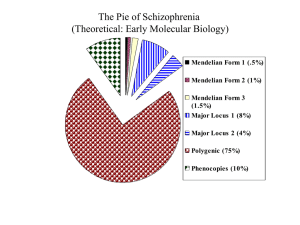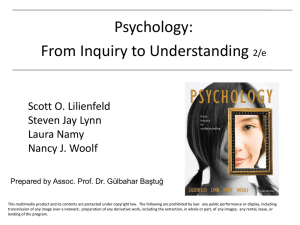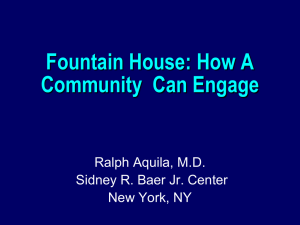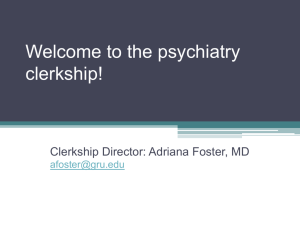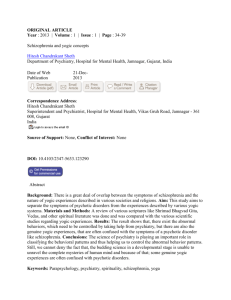Question: What is the cause of her psychiatric problems according to
advertisement
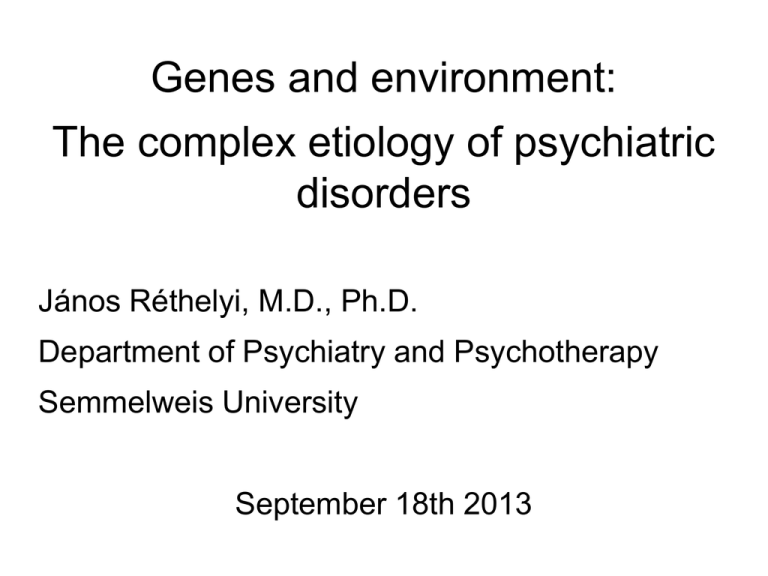
Genes and environment: The complex etiology of psychiatric disorders János Réthelyi, M.D., Ph.D. Department of Psychiatry and Psychotherapy Semmelweis University September 18th 2013 Outline • The issue of Gene-Environment Interactions: Why are they important? • Methods in psychiatric genetics • Psychiatry in a nutshell: Dementia, Schizophrenia, Depression, Bipolar Disorder, Personality disorders. • Implementation of genetic results: Pharmacogenetics, drug development, prevention. Case presentation • 23 year old female patient presents herself at the Department after a family debate. • Chief complaints: „I am treated brutally by my family… I think people on the street mean bad to me…” • Following examination: symptoms of anxiety, paranoid and religious delusions, acoustic hallucinations (I heard the voice of Jesus.) Question: What is the cause of her psychiatric problems according to the patient? According to you? Questions • • • • How do we call the decribed condition? What is the most probable diagnosis? What other diagnoses should we think of? What is the cause of her psychiatric problems according to the patient? • According to you? • The fundamental question of etiology: What causes the disorder? Environmental or genetic factors? Psychiatric disorders ● Mental disorders: significant dysfunction in an individual’s cognitions, emotions, or behaviors ● ● Diagnoses based on behavioral assessment, no lab tests or biomarkers are available (except for organic psychosyndromes) Why do we think that they have anything to do with genes? Heritability of psychiatric disorders ASD: autism spectrum disorders AD: Alzheimer dementia ADHD: attention-deficit hyperactivity disorder AN: anorexia nervosa ALC: alcohol dependence BIP: bipolar disorder BRCA: breast cancer CD: Crohn disorder MDD: major depressive disorder NIC: nicotine dependence SCZ: schizophrenia T2DM: type 2 diabetes mellitus From: Sullivan et al, 2012. Genetic architectures of psychiatric disorders: the emerging picture and implications. Nature Genetic studies ● ● Population genetics: ● Molecular methods – Family studies – Linkage studies – Twin studies – Association studies – Adoption studies – Expression studies – (epigenetic analyses) Epidemiologic studies: – Genetic cohorts ● Animal models A typical genetic analysis workflow Population studies Molecular methods Candidate genes (polymorphisms) Epidemiologic analyses biological hypotheses Genetic Risk Results of Psychiatric GWAS Studies …the interpretation Schizophrenia ● ● ● ● Main symptoms: delusions, hallucinations, disorganized thoughts and behavior Familial transmission is straightforward (heritability: 0.8, MZ twins: 48-59%, DZ twins: 16% concordance) Referred to as the totally unsuccessful example of linkage and association studies GWAS studies did not replicate previously implicated candidate genes, and significant markers only explain 3% of the heritability -> “missing heritability” Candidate genes in schizophrenia Question Which character suffers from schizophrenia in one of Shakespeare’s dramas? John William Waterhouse: Ophelia Edgar - Tom O’Bedlam (King Lear) Alzheimer dementia ● ● ● ● ● Main symptoms: Progressive deterioration of cognitive abilities, agitation, hallucinations. Neurodegenerative disease, EC: neuritic plaque, IC: neurofibrillar filaments, beta-amiloyd Familial AD (5%): mendelian transmission, dominant, early manifestation: APP (amyloid precursor protein), presenilin1, presenilin 2 Sporadic AD (95%): polygenic, late-onset: apolipoprotein E e4 allele risk factor, GWAS replicated APP gene on chromosome 21- association with Down-trisomy Mood disorders ● ● ● Depression: depressed mood, performance problems, somatic symptoms (loss of appetite, sleep problems) Mania: elevated mood, hyperactivity, decreased critical insight Bipolar disorder: cycles of depression and mania, social disability, family problems, high suicide risk DEPRESSION: abnormal sadness, loss of joy and motivation, decreased energy, desperation, and suicide Van Gogh Hemingway Genetics of mood disorders ● ● ● ● Highly prevalent disorders (MDD~15%, BD~6%) Familial transmission straightforward in BD (h2: 0.8, MZ: 65%, DZ: 14%), moderate in MDD (h2: 0.39, MZ:50%, DZ:18%) GWAS studies yielded a few significant markers in BD with only 1 gene in concert with linkage results (CACNA1C, OR=1.14), again explaining only 2% of heritability variance No markers reached significance in MDD, and the main candidate gene (SLC6A4) association was dismissed by recent meta-analyses What is the explanation? Why can’t we find the genes for schizophrenia, dementia, or depression? Although psychiatric disorders have a high heitability we couldn’t identify individual genes or polygenic models. Gene-gene interactions? Epistatic and other regulatory mechanisms? Is there any other factor that we should consider? Gene-Environment Interactions ● ● Refers to the phenomenon where genetic and environmental factors both play a role in the etiology of a disease and possibly strengthen each others effect. Especially important in chronic non-communicable diseases and psychiatry. ● Elucidating GxE interactions can lead to better ● prevention and therapeutic measures. ● The field is connected closely to psychiatric ● genetics. Caspi és Moffitt, 2006. Gene-Environment Interactions ● ● ● ● Synergistic: G and E factors enhancing each others’ effect Antagonistic: G and E suppress each other Vulnerability model: G predispose a sensitivity towards E stressors Plasticity model: G may confer susceptibility, but can be beneficial in optimal E Gene-Environment Interactions From: van Os et al., 2010. The environment and schizophrenia. Nature Environmental risk factors in schizophrenia From: Sullivan, 2005. The Genetics of Schizophrenia. PloS Medicine Environmental risk factors in schizophrenia From: van Os et al., 2010. The environment and schizophrenia. Nature The influence of adolescent-onset cannabis use on adult psychosis is moderated by variations in the COMT gene Caspi et al, 2005. 13% of individuals carrying the Val/Val genotype and using cannabis had schizophreniform disoder Good idea to genotype yourself before you fly to Amsterdam. GxE effect on psychotic outcomes From: van Os et al., 2010. The environment and schizophrenia. Nature Serotonin transporter (SLC6A4, 5-HTT) Lesch et al, 1998 Location: 17q11.2 Major regulatory element in the serotonin transmission and primary target of antidepressant (SSRI) medications S allele (14 repeats) -> reduced expression level and slower serotonin turnover L allele (16 repeats) -> normal expression level and serotonin turnover Influence of Life Stress on Depression: Moderation by 5-HTTLPR From: Caspi et al, 2003. Science Influence of 5-HTTLPR on Depression: Moderation by Environmental Risk From: Belsky et al., 2009. Vulnerability genes or plasticity genes? Molecular Psychiatry Influence of 5-HTTLPR on Stress-Reactivity: Moderation by Environmental Risk From: Muller et al, 2011. Interaction of Serotonin Transporter Gene-Linked Polymorphic Region and Stressful Life Events Predicts Cortisol Stress Response. Neuropsychopharmacology Sounds good so far, but… Reanalysis of the original data, and new data from the 30 year follow-up study (Dunedin cohort)(Fergusson et al, 2012, Munafò et al., 2009, Risch et al, 2009) don’t support the original interaction between 5HTTLPR and stressful life events. The interface of GXE: The epigenome Epigenome: Charactreistics of the genome that are not related to the DNA-sequence (DNA methylation pattern, histon acethylation or methylation, chromatin structure) Many changes in early phases of development (malnutrition, parebtal neglect, abuse) Tissue-specific Epigenetic changes can be inherited up to 3 generations Epigenetics findings Methylation status of BDNF promoter is associated with MDD in a Japanese sample (Fuchikami et al, 2011). Voluntary exercise in mice induces demethylation in neurons (Pinilla-Gomez, 2012) Intense exercise and IL-1ß, TNF-α change in humans predicts remission of patients with depression (Rethorst et al., 2012) Critics of the scientific community: Current results don’t support the use of genetical testing for diagnostic purposes. Ethical problems! GxE and Therapy ● ● ● Therapy itself is an environmental factor, introducing epigenetic modifications Pharmacogenetic variations are important in predicting treatment response (eg. COMT Val158Met, CYP2D6, CYP3A4, HTR2A polymorphisms on response to clozapin) CYP2D6, CYP2C19 poor or ultrarapid metabolizers need personalized dosage of psychotrop meds From: JC Stingl et al., Genetic variability of drug-metabolizing enzymes: the dual impact on psychiatric therapy and regulation of brain function. Mol Psych (2012), 1-15 From: JC Stingl et al., Genetic variability of drug-metabolizing enzymes: the dual impact on psychiatric therapy and regulation of brain function. Mol Psych (2012), 1-15 Changes in activity of amygdala, prefrontal cortex and hippocampus in depressed patients after successful psychodynamic psychotherapy Buchheim et al., 2012 Differences in D2 receptor binding after successful cognitive-behavior therapy in patients with social anxiety From: Cervenka S. et al, 2012 Take-home messages ● ● ● ● Genetic and environmental factors are both extremely important in the etiology of psychiatric disorders Schizophrenia: high heritability, demonstrated geneenvironment interactions for urban upbringing and cannabis use. Major depression: moderate level of heritability, demonstrated interactions between HTTLPR and stressful life events Understanding gene-environment interactions is very important for the treatment as well Thank you for your attention! rethelyi.janos@med.semmelweis-univ.hu

